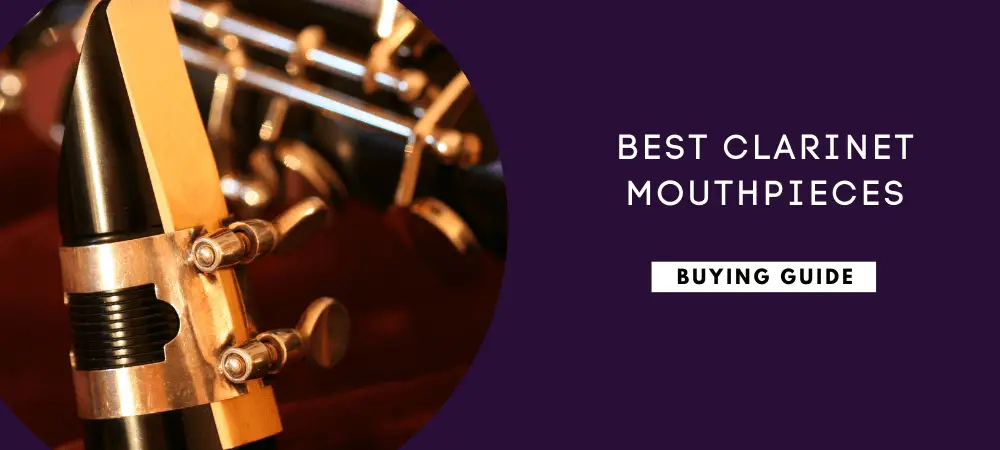Though physically and technically speaking, the clarinet remains a little bit simpler than the saxophone, it also produces sounds through the reeds.
And this could only mean that the quality of this instrument goes beyond its physical beauty.
Instead, there are various components, such as the mouthpiece that largely define the quality of the tones produced.
That’s why you should always pay close attention when shopping to ensure you settle for the best clarinet mouthpiece.
Table of Contents
Best Clarinet Mouthpieces for Beginners
This Clark W Forbes mouthpiece is one of the best value mouthpieces you will ever come across in the current market.
And although I can’t categorize it as a high-end mouthpiece, because as the name suggests, it’s designed primarily for learning purposes, it presents some of the best features within its range.
It comes in a simple plastic construction and perfectly hand-finished to outplay most mouthpieces that come with clarinets.
This Clarinet is medium-faced, making it ideal for students as it’s easy to control.
And that’s not all.
Most students praise this mouthpiece for its impressively narrow 1mm tip opening that gives them a richer sound whenever they blow.
- Budget-friendly
- Good for learners
- Impressive quality in comparison with other mouthpieces within the same range
- Produces a rich sound
- Not very long-lasting
- Not favorable for live performances
As a brand, D’Addario has proudly managed to rank highly in the best music instruments manufacturers’ list for years.
Their Rico Graftonite Bb Clarinet Mouthpiece is no different.
It comes with a 0.050″ tip opening, complete with a facing length of 19mm.
The mouthpiece promises its student users durability and reliability as it’s made out of polycarbonate, which doesn’t crack or chip easily.
Also, according to numerous positive student reviews, this device provides ease of play, and the tone is quite impressive and decent.
It’s also pretty affordable even for on-budget students, so there’s no reason as to why you shouldn’t check it out.
Besides, it’s available in 3 tip openings and 3 chambers.
- Great for the price
- Produces clear and consistent sounds
- Ideal for beginners
- Easy to play
- The cork is a little bit thick
If you’re a beginner clarinet player and would like to upgrade your instrument’s mouthpiece, then the J&D Hite H111 Premiere should be among your number one considerations.
Why?
The mouthpiece is not only easy to play, but also produces better sounds than most clarinet mouthpieces in the current market.
And to ensure the device is well protected to avoid unnecessary wear and tear, the package comes with a protective cover.
Most students confess that this mouthpiece was a perfect fit for their instruments, so you can expect to enjoy the same privilege.
I also love the fact that it’s made out of hard rubber, which offers impressive quality assurance for a student.
It weighs 1.41 ounces and goes for $25 (Amazon), which is still favorable, considering the wide range of features it presents.
- Sturdy construction
- Affordable pricing
- Easy to play
- Produces great sound
- Few reports on faulty pieces, but the manufacturer’s response is quick
This Selmer Gold tone clarinet mouthpiece is the best that there’s in the beginner category.
It comes with a well-balanced response, complete with an accurate pitch, to give beginners the confidence to continue practicing.
Also, this mouthpiece contains impressive features, the reason as to why music tutors across the globe highly recommend it.
The piece, however, doesn’t come with a Ligature, so you will have to purchase that separately.
But that shouldn’t be a problem as most of them aren’t even expensive.
And although this mouthpiece is made out of plastic, it’s durable enough for regular training.
Students should also note that this medium facing mouthpiece produces a reasonably good tone.
- Easy for students to use
- Good quality plastic
- Decent sound quality
- Great pricing
- A few reports on some pieces lacking markings
Best Clarinet Mouthpieces for Intermediate Players
If yours is a Bb Clarinet, and you’re past the learners’ stage, then the Yamaha Clarinet YAC1266 Mouthpiece 4C makes a significant consideration.
It proudly displays a 1.05 mm tip opening, which I can say is impressively within the narrow rank.
And although its body construction is made out of plastic, the YAC1266 mouthpiece is amazingly durable and can easily be compared with the rest of the Yamaha brand’s high-end tailored series.
When you receive the package, you will notice that this device has a medium facing, which gives better control to intermediate players.
In fact, even beginners can use it.
The downside, however, is that the narrow opening will only work correctly with a softer reed, so don’t expect the tone to be too bright.
But, if you love rich tones, this shouldn’t be a problem. It’s also highly consistent.
For an affordable mouthpiece, I find the features of this device impressive and reliable enough for both tutor-led and self-practice sessions.
- Ease of control
- Produces a natural rich sound, which is consistent
- Pretty affordable
- Decent construction quality
- Isn’t easily compatible with clarinets from other manufacturers.
The Vandoren CM4158 M13 mouthpiece was specifically designed to match the needs of A44o pitch clarinets.
It’s an 88 profile series, and it comes with a distinct exterior beak.
And that’s not all.
This mouthpiece is easy to play in the upper register, and it produces a more natural sound, thanks to its medium-long facing.
It also comes with a hard rubber ligature, which is a plus.
This mouthpiece can perfectly fit both the A and the Bb clarinets, which is advantageous for versatile players.
It’s pricing is quite expensive as compared to other pieces within its range, but with the quality features that Vandoren brand presents it’s a worthy investment.
- Quality natural sound
- Comes with a hard rubber ligature
- Compatible with both the Bb and A clarinets
- Easy to play within the upper register
- Quite expensive
Best Clarinet Mouthpieces for Professional Players
With the stiff competition in the current musical instruments’ market place, it isn’t surprising to see manufacturers trying to do their best to outsmart their competitors.
And this precisely what D’Addario brand tried to proof with their Reserve X0 Clarinet Mouthpiece.
The X0 piece was manufactured explicitly for A441 clarinets, and it proudly displays the use of modern technology with its impressive craftsmanship.
When you first see it, you will not fail to notice the properly polished angles, the fantastic curves, and the top-notch materials used.
And to ensure its players stay on top of their game, this mouthpiece produces one of the most amazing tones you could ever hear from an intermediate clarinet.
It’s the constancy in intonation through the low and high registers that will leave your audience in awe.
The best part is that this reserve pieces come in various facings, so you get to choose what works for your instrument.
Plus, it’s flexible enough to be compatible with other manufacturers’ reeds. Of course, so long as you adhere to the recommendations.
Its ease of playability makes it favorable for both professional and intermediate players, which is a worthy investment, especially for players who are serious about their musical journey.
- Great for both A and Bb Clarinets
- Maintains an impressive tone consistency
- Has a narrow tip
- Suitable even for beginners
- Expensive
- Some players find the tone quality richness insufficient.
The Yamaha YAC 1267 Standard Series 5C Mouthpiece is perfectly designed for Bb clarinets.
The package comes with top-notch phenol resin, and it helps players produce highly consistent sounds, which makes it favorable for professionals.
And because of its amazing features and versatility it presents, this mouthpiece can work perfectly in both solo and band performances.
So if your child loves playing in school bands, then this is an ideal pick for them.
The best part is that beginners and intermediate players can also use this Yamaha YAC 1267 mouthpiece.
So, if you don’t mind spending money right from the beginning, you can as well invest in it and grow with it in your musical journey.
- Promotes a natural and consistent sound
- Can be used by players of all levels
- Easy to control
- Made for Bb clarinets
- Good quality and reliable
- Isn’t compatible with all clarinets
Do Clarinet Mouthpieces Make A Difference?
So much has been said about clarinet mouthpieces. Some say they solely determine the quality of tones produced, while other individuals believe that it’s the entire set-up that really matters.
So, what is the truth? Do clarinet mouthpieces make a difference? Let’s find out below:
First, I would like to point out that mouthpieces do matter, absolutely. Otherwise, there wouldn’t be so many companies scrambling for buyers in the marketplace. We also wouldn’t even be here reviewing them according to importance and quality.
You see, if we compare your Clarinet to a car, then we can readily say that the mouthpiece is its engine.
This means that just as a car engine is important to the driver, so is the mouthpiece to the player. The two are inseparable.
That said, contrary to common assumptions, it isn’t necessarily true that buying an expensive mouthpiece will automatically give you a much better sound.
You have to pair it with the correct reeds for its mouthpiece facing for great results. If you wrong here, then no matter how expensive and high quality your mouthpiece is, you will struggle to make decent sounds, and sadly, that is about it.
Another thing, it’s always important for the mouthpiece to match with the type of player and also the instrument used. And this also means the kind of music style you play.
Remember, people have different embouchures, and that’s why it’s vital to keep trying the various available sizes until you find your match.
It’s also vital for the player to know how they want to sound like. This way, they can come up with the right embouchure, position their tongues well, and help the mouthpiece to accomplish a perfect sound.
So, It really wouldn’t be surprising if a player sounds much better when using a “lesser” quality mouthpiece. As opposed to a sound, another player can get out of a more expensive mouthpiece.
The player and their determination really matter.
Also, it won’t be surprising for a relatively good player not to be able to get a decent sound from a good quality mouthpiece.
Basically, as a player, you should be ready for a trial and error period to help you identify what works best for you, not, forgetting the type of reeds to use.
Therefore, if you’re comfortable with the current tone that your mouthpiece helps you achieve, you might want to stick with it for a while. Especially if you aren’t ready for the rigid trial and error sessions.
But, most experienced clarinet players do confess that upgrading a mouthpiece can drastically improve the quality of tone produced.
Also, while this is good news, you should be ready to put up more work to attain the kind of tome you want, if necessary.
Furthermore, the quality of the material used in the construction of the mouthpieces significantly affects the different tones produced.
So, if, for example, you aren’t consistent with the types of music you play, then you might as well opt for a versatile mouthpiece that will perfectly suit the general mix.
Another critical point to note is that various mouthpieces significantly change the strength of the reeds. For example, if the mouthpiece is open facing, then you will need a softer reed and vice versa.
Also, the more open facing the mouthpieces are, the more expressive and flexible it will be for you to bend the pitch. And of course, this will significantly change the volume.
If you want to achieve a more solid rich tone, you should opt for a close facing mouthpiece. You will, however, have a lot to do when bending pitches and doing various dynamics.
What is the bottom line?
Yes, Clarinet mouthpieces do make a difference, but the player should also know how to embouchure for best results.
How to Choose the Right Clarinet Mouthpiece
Material Construction
Like any other musical instrument, the current market is filled with various types of clarinet mouthpieces made from different kinds of materials.
The most common ones are plastic, wood, and crystal made mouthpieces.
The plastic mouthpieces tend to be of decent quality and cheap, making them ideal for student players. They also produce excellent tones, which are hassle-free to achieve.
For advanced players, one can easily come across wood or crystal made mouthpieces, which are more durable and versatile than the wooden pieces. They also tend to be more expensive.
So, depending on the material you’re comfortable with, you should be able to choose the best mouthpiece for your instrument.
Check Out for The Various Mouthpiece Accessories
Yes, the mouthpiece does have supportive accessories. First, there is the ligature, which you can purchase separately, or if you’re lucky, some manufacturers include it in the mouthpiece package.
It’s the ligature that you will use to cover the mouthpiece on your Clarinet, and also give a decent hold to your reed.
You can also purchase the mouthpiece cap separately if you want.
Remember, the primary function of the mouthpiece is to protect your Clarinet, so any accessory that will help it fulfill its purpose is equally important.
Examine the Tip and The Lay
The mouthpiece’s tip is a crucial part of your Clarinet. This is because it significantly determines how easy it will be for you to produce decent sounds.
Generally, there are two types of mouthpiece tips: closed or open.
So, if, for example, you prefer producing a louder tone, then you should consider a mouthpiece with an open tip.
But if a darker tone is your preference, then a closed tip makes a perfect choice.
If you want to achieve a middle-range tone (not too loud or too dark), then get a medium-sized mouthpiece tip.
Sidewalls and Chamber
When it comes to mouthpieces, the side walls are normally located in the insides. And therein, you will find the Chamber, which will lead you to the mouthpiece’s main Chamber (open space).
Therefore, as you blow, the quality of tone you produce, and the amount of volume that gets out largely depends on both the size and the shape of these sidewalls.
For example, if you want to achieve more focused tones in your performance, then it’s advisable to go for narrow-shaped mouthpieces.
But if you won’t mind a bigger tone, then a larger chamber will do.
Used Clarinet Mouthpieces
People rarely talk about used Clarinet mouthpieces. But they do exist, and some players find them more interesting than new ones.
So, although experts recommend using new mouthpieces (I also would), this is a topic worth discussing.
This option is mostly applicable for players working on a tight budget and wouldn’t want to miss their training/performance sessions.
The first thing you should consider is the material. Choose one that suits your needs (I have already talked about this above, so I won’t go into many details.)
Afterward, check out for any visible chips or cracks. You should go for a mouthpiece without any of this.
You can overlook the slightly discolored mouthpieces unless the physical appearance of your Clarinet’s accessories matters a lot.
Remember, to always select a mouthpiece that’s in perfect condition, whether used or new.
And lastly, purchase from a reputable source. The more you know about the seller, the better.
But if you have to purchase online (as a last resort), proceed with caution.
FAQs About Best Clarinet Mouthpieces
How Long Do Clarinet Mouthpieces Last?
Honestly, there is no straight answer to this question because it depends on several factors.
For instance, you can’t compare the longevity of a frequently used mouthpiece, with one that’s rarely used.
Of course, if you play six days a week, the chances are that you will need to change your mouthpiece pretty earlier than someone who plays twice a week.
Another factor is how well you maintain your mouthpiece.
But even with these factors, generally speaking, mouthpieces, like any other musical devices and accessories, do war down in due time.
And this is normal, because of the immediate environmental factors and the saliva spits that get into it as you play.
However, if yours is a quality mouthpiece and you happen to be a regular clarinet player, then you might start experiencing some mouthpiece issues in 2-3 years.
Can You Clean Your Clarinet Mouthpiece in Water?
Yes, you can. But not all parts.
Remember, your Clarinet is made up of 5 parts: the bell, lower joint, barrel, upper joint, and the mouthpiece.
You can, for instance, wash the mouthpiece using regular soap, a small specialized cleaning brush, and some warm water. If you can’t afford to buy a brush, use a baby-size brush.
Some people use vinegar, and that’s also fine.
You should, however, never use water to clean the rest of the parts as you might end up destroying the tone holes pads, and that’s the last thing you want.
Check out the YouTube video below on how to properly clean your clarinet mouthpiece like a professional:
Do Clarinets Wear Out?
Clarinets are made out of various materials. And therefore, the time they take to wear out largely depends on the quality of their construction.
But to quickly answer your question, I would say yes. Clarinets, like other wind instruments, do wear out.
They, however, take several years for that to happen. For example, a simple standard quality student instrument can last up to 10 years before showing any signs of wear and tear.
So, a professional model will last almost a lifetime.
But of course, this has to be with proper care.
That’s why I would say that clarinets are a worthy investment, especially when you know which musical journey you would like to take.
What Are the Best Clarinet Mouthpiece Brands?
As mentioned earlier, there are various types of clarinet brands in the market. Some are top-ranked, while others are low-ranked.
In 2021, some of the best clarinet mouthpiece brands include:
- Yamaha
- Clark W Fobes
- Vandoren
- Selmer
- D’Addario
- J&D Hite, among others.
We have reviewed some of their best mouthpieces in this article, so the selection process should be easy.
Conclusion
The Clarinet is divided into many parts. And it’s the collaboration of those parts that determine how much of a good or bad player you can be.
In my previous article, I talked about the reeds, and today I have covered the mouthpiece. These two are essential parts of your instrument, and they work hand in hand.
Therefore, you should always be careful about the type of mouthpiece you choose, as it will significantly impact the tone you produce.
Start by identifying the type of music you want to play that way, you can comfortably choose between an open and closed tip mouthpiece.
Other factors to consider are the material, the size of the Chamber, and, of course, your budget.












